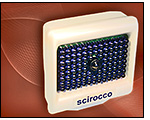gaining broader acceptance as a robust technology that can be used for many applications. But two Scandinavian companies say there are niche applications where radio waves are a less-than-ideal means of identifying objects.
Sonitor Technologies, a Norwegian startup, has developed an indoor positioning system that uses battery-powered tags that have accelerometers—sensors that respond to movement. When a tagged object moves, its tag emits a series of ultrasound tones that humans can’t hear. A detector picks up the tones from as far away as 45 feet, translates them into a serial number and sends that number along with its own detector identifier to a software system residing on a central server. The software knows which room the detector is in and displays the room where the object was “heard.” When the object stops moving, the tag goes back to sleep.
Ultrasound’s advantage over RFID? It can’t penetrate walls, so when a tag is detected in a room, you can be certain the object is in that room. But it can become a disadvantage when an object can’t be found because it’s in, say, a sealed cabinet.
Ragnar Bo, Sonitor’s CEO, says ultrasound is great for tagging assets, such as wheelchairs, gurneys, pumps and other medical devices and personnel in hospitals. Ultrasound doesn’t interfere with electrical equipment used in hospitals, which could be a concern with RFID.
Given the price tag today—about $30 per tag and $150 per reader—the value of assets tracked has to be fairly high. But Bo says his company plans to move production to Asia, and when volumes ramp up, the tag’s cost should fall to $10.
Scirocco, a Swedish systems integrator, had the bright idea of using infrared technology to transmit information. Staffan Sjogren, Scirocco’s managing director, says infrared bridges the gap between short-range low-frequency RFID systems and longer-range UHF or active systems, which can have a read range of 15 feet (5 meters) or more. Its Solar Tags can be read from as far as 12 feet (4 meters).
The tags gather energy from the sun or other light sources and continually send out infrared signals that contain a unique 32-bit serial number. The tags can store up to 128 bytes of additional data. The system is immune to most forms of electromagnetic interference.
Scirocco is targeting three main markets: vehicle identification, manufacturing automation and parking. Sjogren says the company hasn’t finalized pricing, but the readers will cost about as much as high-end low-frequency RFID readers, and the tags will be priced competitively with active RFID tags. The tags don’t work in perpetually dark places without artificial light to power them up, but Solar Tags could have a bright future in certain industries.


